The NVIDIA GeForce GTX 750 Ti and GTX 750 Review: Maxwell Makes Its Move
by Ryan Smith & Ganesh T S on February 18, 2014 9:00 AM ESTOverclocking: When Headroom Exceeds Clockspeed Limits
Last but not least we have our customary look at overclocking performance. With all 3 of our cards being based on the same reference design, we expect to see some relatively consistent results between the cards. At the same time NVIDIA has told us that GTX 750 has some very interesting overclocking properties, and boy they weren’t kidding.
On a quick note, as a GPU Boost 2.0 product, overclocking on the GTX 750 series is not any different than on other GTX 700 series cards. It’s still based on offset overclocking, with the user adjusting offsets for the final overclock. But with that said there are two things to point out. The first is that the power target is limited to 100% on all cards. Because these are sub-75W cards, NVIDIA is not allowing anyone to exceed the card’s default TDP, so you only have as much power to play with as you started with. Second of all, none of our cards had available overvoltage bins. Apparently some cards do, but ours did not, so our voltage bins maxed out at the default bins you see listed.
Finally, all 3 cards have a maximum clock offset of 135MHz. This will be an important fact in a little bit.
| GeForce GTX 750 Series Overclocking | |||||
| GTX 750 Ti (Ref) | Zotac GTX 750 Ti | Zotac GTX 750 | |||
| Shipping Core Clock | 1020MHz | 1033MHz | 1033MHz | ||
| Shipping Max Boost Clock | 1150MHz | 1175MHz | 1163MHz | ||
| Shipping Memory Clock | 5.4GHz | 5.4GHz | 5.0GHz | ||
| Shipping Max Boost Voltage | 1.168v | 1.137v | 1.187v | ||
| Overclock Core Clock | 1155MHz | 1168MHz | 1168MHz | ||
| Overclock Max Boost Clock | 1285MHz | 1310MHz | 1298MHz | ||
| Overclock Memory Clock | 6.3GHz | 6.1GHz | 6.0GHz | ||
| Overclock Max Boost Voltage | 1.168v | 1.137v | 1.187v | ||
As we can quickly see, two patterns emerge. The first is that with every card equipped with 6GHz memory (though we remain unsure which mode the Zotac GTX 750’s is in), each and every card hits at least 6GHz, and sometimes a bit more. With the 128-bit memory bus generally providing the biggest bottleneck for GM107, the fact that there is 12%+ overclocking headroom here is going to be very helpful in feeding the tiny beast that is GM107.
More significantly however is the core overclock. We maxed out every single one. Every card, from the NVIDIA reference card to the Zotac cards, had no trouble overclocking by the full 135MHz to their respective maximum overclocks. The Zotac GTX 750 Ti, having the highest maximum boost clock by default, is technically the winner here at 1310MHz. But at this point everyone is a winner. Going by the maximum boost clock, every card is capable of an 11% core overclock, to go with that tasty 12% memory overclock.
The fact of the matter is that this is not something we normally encounter. Sub-75W cards are not poor overclockers, but they’re not usually strong overclockers either, which is why a 135MHz offset limit makes sense at first glance. But it’s clear that NVIDIA underestimated their own overclocking potential here when setting the specifications for these cards, as there’s seeming some headroom left untapped. Without additional offset room it’s impossible to say just how much more overclocking headroom remains – it may not be very much – but there should be room for at least some additional overclocking.
At this point with cards already in the pipeline we’ll have to take a look at individual cards and see what manufacturers have set their offset limits at. If they have followed NVIDIA’s specifications, then they’ll be equally limited. But hopefully with the launch now behind them, NVIDIA’s partners can work with NVIDIA on making greater offsets available on newer batches of cards.
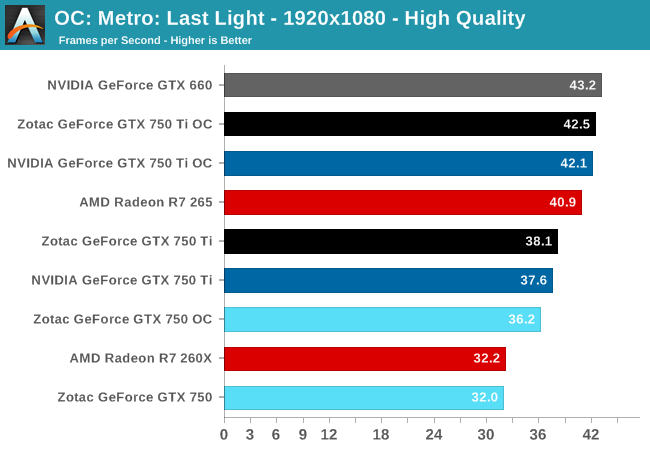
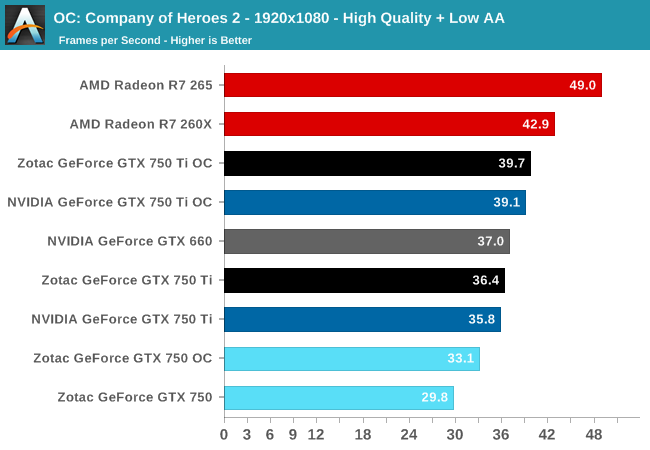
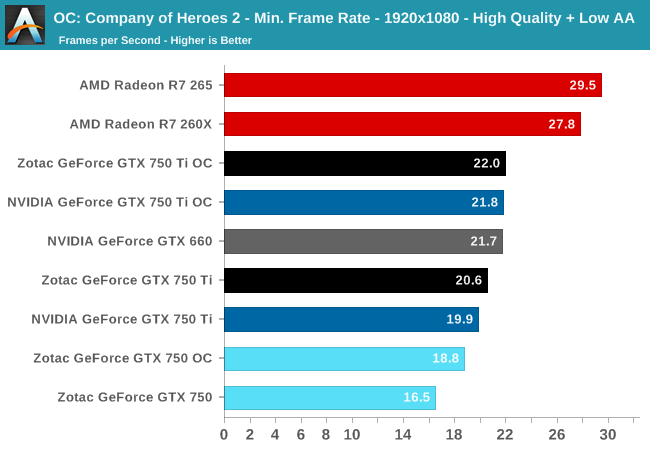

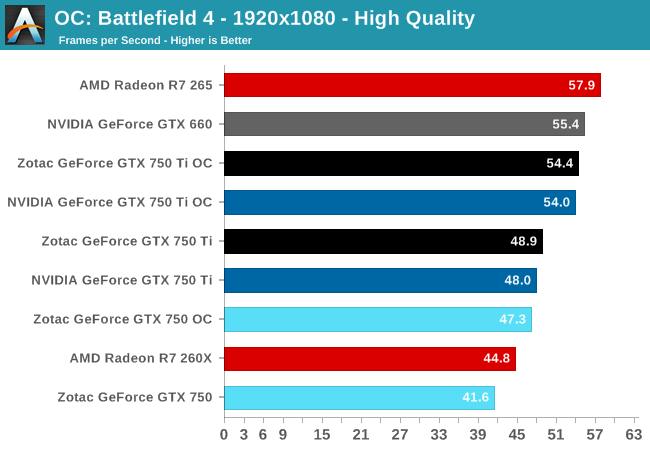
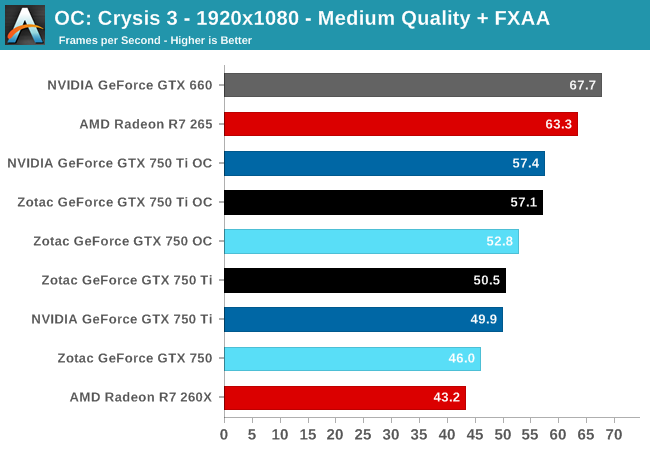
Depending on the game being used, the benefits from overclocking range from 9% to 12%, roughly in-line with our overclocks. For the GTX 750 this is sometimes enough to catch the stock clocked R7 260X, but even with this overclock the GTX 750 Ti will still generally trail the R7 265.
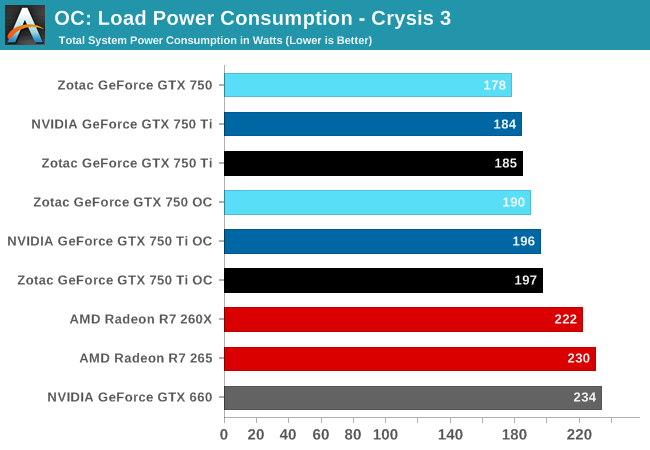

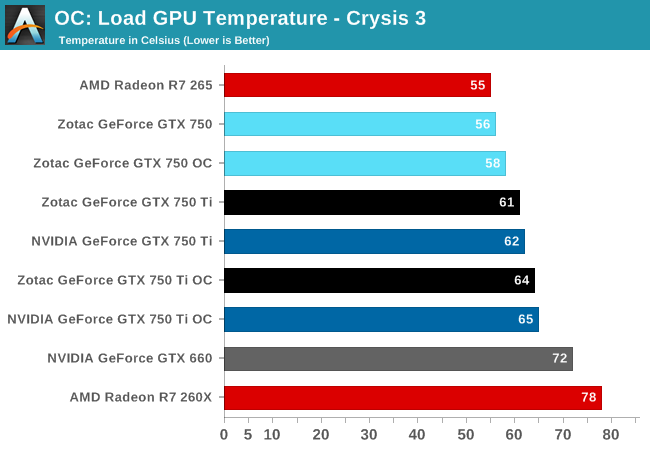
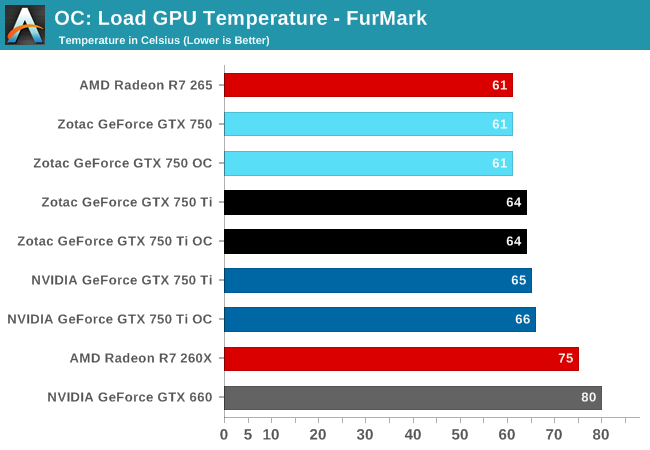
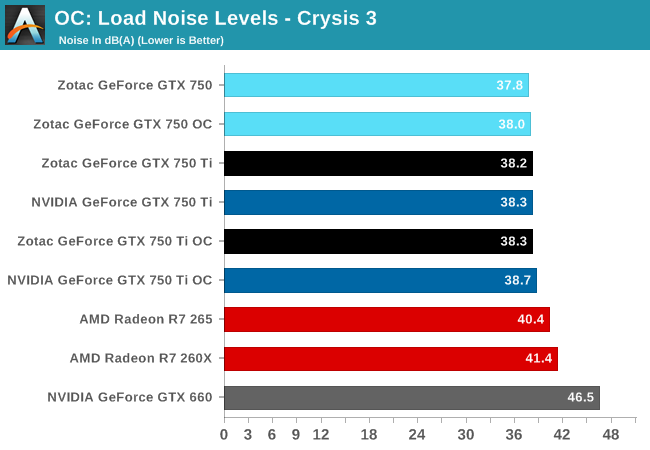
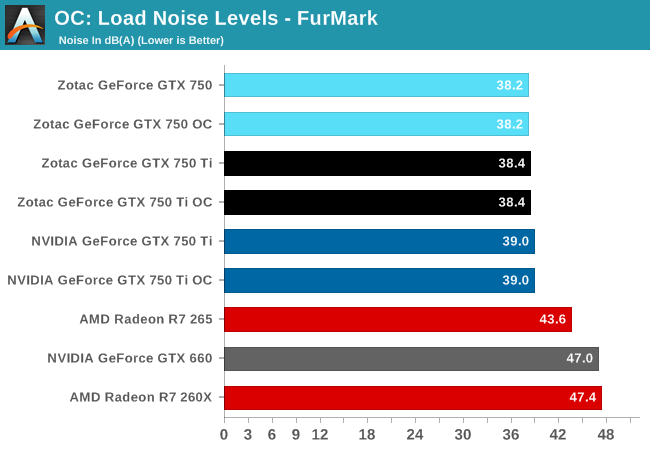
On the other hand, because of the hard TDP limit of 100%, this extra performance is relatively cheap. Video card power consumption moves by only a few watts, and then a few watts of CPU time on top of that. For all practical purposes overclocking can extend NVIDIA’s already incredible performance-per-watt ratio by another 10% with no meaningful impact on noise. Given the consistency of overclocking headroom we’ve seen in our GTX 750 series samples, this is one of those scenarios where overclocking is going to be a reasonable and (relatively) fool proof action to take.










177 Comments
View All Comments
EdgeOfDetroit - Tuesday, February 18, 2014 - link
The EVGAs have Displayport, but they might be the only ones. I ordered the Superclocked 750 Ti with the $5 rebate from Newegg because it had a DisplayPort and the competitors did not.Death666Angel - Tuesday, February 18, 2014 - link
"the 760 has been out for almost a year now and is an older process" -> Still the same 28nm process for the 760 and 750 alike. :)MrPoletski - Tuesday, February 18, 2014 - link
This jump in cache for 128k to 2mb... I wonder what that does for cryptocurrency mining?The Von Matrices - Tuesday, February 18, 2014 - link
Unless the integer shift operation has been improved, not much.g101 - Tuesday, February 18, 2014 - link
Nothing, nividia is fundamentally deficient with integer compute, these are architectural decisions that NVidia made in hopes of squeezing out slightly better FPS. Think: anti-gpgpu, or more of a classic asic.So no, this arc isn't going to change their position with regards to the actual algorithms. Perhaps there will be a moderate increase in sCrypt sha2 performance (due to the memory-hard nature of that implementation), however, nvidia's extreme (and sometimes intentional) incompetence with gpgpu leads me to believe that they still do not understand that GPGPU is the reason AMD's cards are above MSRP. It's not due to one specific hashing function, it's due to their superiority in over 11 specific functions, superior general opencl performance and comparatively greater performance for many SP compute intensive CUDA applications. For instance, cross-comparison between cuda and opencl raycasting yields some very interesting results, with the opencl/AMD solutions outperforming cuda 2:1, often with greater accuracy.
CUDA is easy, NVidia has zero compute advantage beyond 'ease'.
oleguy682 - Tuesday, February 18, 2014 - link
AMD receives nothing for their cards being sold over MSRP. Their channel partners likely have agreements in place for this generation of processors that is locked in at a specific price or price range. Perhaps if they signed new partners, or revised their processors substantially enough to warrant a new agreement, they can take advantage of the higher-than-MSRP situation, but I doubt it. And even the ASUS and Gigabytes of the world are likely unable to capitalize much on the demand. At best, they are able to sell boards to retailers as fast as they come off the line.Only the Neweggs are profiting handsomely off of this.
HighTech4US - Wednesday, February 19, 2014 - link
Von and g101 you are both wrong as Maxwell has now greatly improved integer compute. Check out the following review page from Tom's:http://www.tomshardware.com/reviews/geforce-gtx-75...
Quote: Historically, Nvidia's cards came up short against competing Radeons, which is why you see R9 290X boards selling for $700 and up. But the Maxwell architecture's improvements allow the 60 W GeForce GTX 750 Ti to outperform the 140 W GeForce GTX 660 and approach AMD's 150 W Radeon R7 265, which just launched, still isn't available yet, but is expected to sell for the same $150. On a scale of performance (in kH/s) per watt, that puts Nvidia way out ahead of AMD. Today, four GM107-based cards in a mining rig should be able to outperform a Radeon R9 290X for less money, using less power.
Yojimbo - Wednesday, February 19, 2014 - link
Which is good for NVidia, maybe just lucky. Increasing gamer market share in exchange for some short-term profits is probably a good trade-off for Nvidia. If AMD can't maintain their market share, they'll have less muscle behind their Mantle initiative.hpvd - Tuesday, February 18, 2014 - link
Does this first small Maxwell brings Support for Unified Virtual Memory Management IN HARDWARE? If yes: would be really interesting to see how efficient it could work...details see:
http://www.anandtech.com/show/7515/nvidia-announce...
willis936 - Tuesday, February 18, 2014 - link
I would like very much to see a comparison of GM107 in SLI to other $300 graphics card options. Us 560 Ti owners are in a tough position because it's upgradin' time and there's no decent, quiet solution. SLI is still a bit of a hack and from what I can tell can be more of a compatibility headache than a performance gain. These cards may be the exception though.